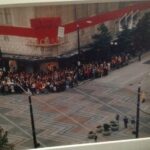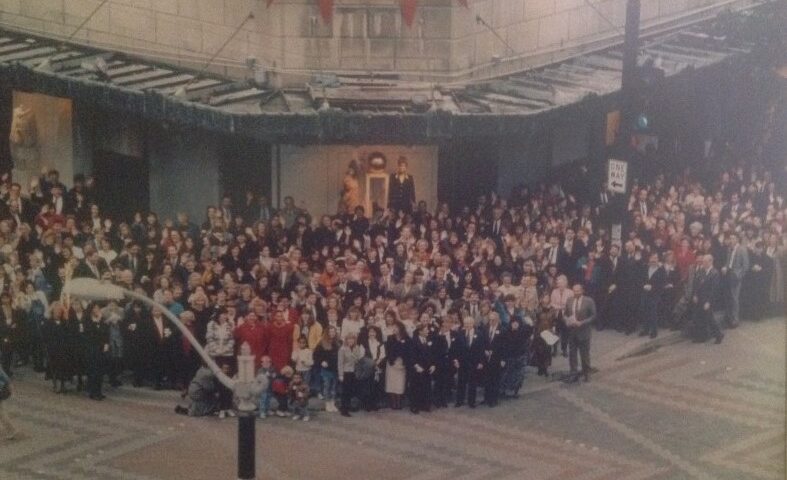Van’s Shoes [Case Study The Proposal] 1996
January 18, 2012
Retail Environment 1990 – 2000
January 18, 2012
The World/Social Trends – “Greed, for lack of a better word, is good”, the line from Michael Douglas’ character in “Wall Street” typified the 1980’s
– To others, the 80’s were the “Ronald Reagan era”
– John Hinckley tried to assassinate Ronald Reagan
– Society-changing events and innovations – home computers, the start of the spread of AIDS, the assassination of John Lennon, and the Challenger disaster
– MTV emerged, and then really took off – bands didn’t release a record without a video
– Tylenol tampering
– George H. W. Bush uttering his famous “Read my lips – no new taxes”
– Madonna and Michael Jackson were among the dominant names on the music scene
– “Thriller” is still today one of the biggest-selling albums of all time
– Oliver North, Iran-Contra, Tiananmen Square
– Shoulder pads and leg warmers became fashionable
– “Dallas” – everyone had their theory who shot J.R.
– Rubik’s Cube, Cabbage Patch Kids
– A time of “bad music, bad hair, bad styles”
Comments taken from CBS “The Early Show” aired on November 13, 2008.
_________________________________________________________________________________________
The Baby Boomers were just starting to make an impact in the workplace – women join the work force – 2 people working per household.
The Merchandise – As Brands became more important, at first people were proud to wear Key Brands
– By the end of the 80’s, people wanted more individual identities
– Because so many people were joining the work force, especially women – the work clothing revolution – Dress for Success
– Brands became status symbols
– The Home Business began to explode – as everyone was now working
– People invested in the Home – Kitchen/House wares exploded , leather business exploded as well as linens, home accessories became key fashion leaders.
Key Items – There were less Items – though Best Sellers/Styles stayed important
– The consumers went more to Brands – and lots of effort went into wearing the right look/brand
– The Baby Boomer would wear an entire outfit from one Brand
Production – The Value/Price concept started to change as Japan, China and India all produce quality
– Manufacturers with different price structures would now produce merchandise in the same location
Focus of Meetings – Merchandise Meetings became more focused on the Brands – and associating Key Brands to your Store’s Identity
_________________________________________________________________________________________
Communication Strategies – The mix of communication changed radically – Newspaper was still very important, but Direct Mail and Television became the focus of communication
– Impact was getting consumers to know you carried the right Brands
– The biggest effort was to do Product Knowledge Training and coordinate it to the Promotional Calendar
Marketing – The major change was the Promotional Calendar grew, and grew, and grew
– The $ spent on Advertising and Promotion grew with the success of selling Branded merchandise
– The calendar went from 1 promotion per month to what seemed like a never-ending opportunity for a sale
– The One Day Sale began late in the decade and, by the end of the 80’s, it seemed to always be on sale
– The growth of the promotion of the Store Credit Card was huge – companies started to earn more on the Credit business than the Merchandise efforts
– Plus getting someone to purchase on the Store Credit Card ensured you knew where to send the targeted Direct Mail – lots of investment went into data-based intelligence
_________________________________________________________________________________________
The Positioning Factors
Quality + + – Brands determined Quality
Value / Price – – The word “Sale” drove the importance of Value
Selection + – Selection became more about the Brands and Home Merchandise
Service + + – Service was driven by the Masters – Personal Trade
Image / Cool + – Brands drove the Cool factor
_________________________________________________________________________________________
Customer Service – Customer Service was driven by all the people working – so everyone experienced customer service from both the provider and as a receiver
– The basics of eye contact, helpfulness, product knowledge, and positive attitudes became the norm
_________________________________________________________________________________________
What was Loyalty – Loyalty moved with the growth of the importance of Brands
– People’s identity became involved with which clothes they wore, the thread count of the sheets, and the make of their car
– Customer Service became a basic standard for all companies – you either provided the basic standard or you had to rely on cheap??
– The game changed to making sure your policies, pay scale, service standards, and employee retention efforts all worked together




